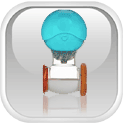However, not all foods are suitable for hamsters such, as sweets made for humans, or poisonous plants such as the leaves of the tomato or rhubarb may be dangerous to the hamster's health.
Both water and vegetables must be fresh and have to be changed frequently, usually once a day. They should be given in small amounts for gnawing or be replaced by special treats, which can be found in pet stores.
Fresh food is also an important part of the hamster's diet. Cucumber is a good supplement of water. Fresh carrot, spinach, broccoli, turnip, parsley, leaves and even branches of non-poisonous plants are also no problem in general. In addition, no fresh conifer wood must be fed since resin is poisonous for hamsters. Hamsters are known to appreciate Tofu. In smaller amounts, grown hamsters also appreciate apple, pear, sweet paprika, banana, mango and strawberry. Too many sweet fruits on the other hand are not healthy. All kinds of cabbage should be avoided, since they may cause flatulence, which is quite dangerous for the hamster's sensitive digestion system. It is also dangerous to feed a hamster raw potatoes or potato tops, raw kidney beans, raw rhubarb or rhubarb leaves.
It might be noted that many hamsters tend to carry away food from their food source (by carrying it in their cheek pouches) and hoard it away in a cache hidden somewhere inside their container. These caches, when combined with hamster droppings or a leaky water source and poor airflow, can grow mold or start to rot, creating a hazardous environment for the hamster. To keep this from happening, clean hamster cages frequently.
To ensure a well balance diet, include a Mineral Block or Mineral Stone in your hamster's cage.
 |

You should always make sure that your hamster has fresh water available. You should change the water daily. Being small animals that are adapted to the life in arid environments, hamsters can also ingest all necessary liquid via sufficient amounts of watery vegetables, such as cucumber, without any negative effects. |